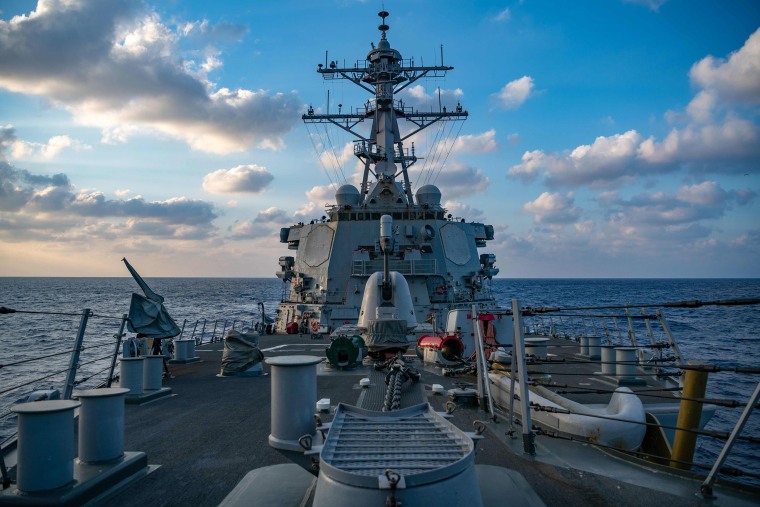China's military said it "expelled" a U.S. navy vessel from the hotly contested waters of the South China Sea this week. It said the "USS Barry" had illegally entered China's Xisha territorial waters on Tuesday.
U.S. officials disputed the account.
China's Southern Theater army command "organized sea and air forces to track, monitor, verify, and identify the U.S. ships throughout the journey, and warned and expelled them," said Chinese military spokesperson Li Huamin, in a statement.
"The provocative actions of the United States seriously violated relevant international law norms, seriously violated China's sovereignty and security interests, artificially increased regional security risks, and were prone to cause unexpected incidents," he said.
On Friday, a spokesman for the Pentagon denied that Chinese forces had impacted on the U.S. ships' movements during "two successful freedom of navigation operations" earlier in the week — including one involving the guided missile destroyer, USS Barry.
Both had "started and ended at a time and place of our choosing," the spokesman, John Supple, said in an emailed statement.
"At no point were U.S. warships 'expelled' from the South China Sea,” he added.
The South China Sea is a potentially energy-rich stretch of water and home to more than 200 specks of land. It serves as a gateway to global sea routes where approximately $3.4 trillion of trade passes annually.
The numerous overlapping sovereign claims to islands, reefs and rocks — many of which disappear under high tide — have turned the waters into a zone of competing diplomatic interests, embroiling neighbors. Beijing holds the lion's share of these features with approximately 27 outposts peppered throughout.
Tension has been simmering in the South China Sea, of late, particularly between China and its Asian seafaring neighbors Malaysia and the Philippines.
This month Vietnam also lodged an official protest with China, following the sinking of a Vietnamese fishing boat it said had been rammed by a Chinese maritime surveillance vessel near the Paracel Islands, in the South China Sea. China denied the claims and said the Vietnamese boat had illegally entered the area to fish and refused to leave.
Earlier this month, Secretary of State Mike Pompeo told his Southeast Asian counterparts that China was taking advantage of the world’s preoccupation with the coronavirus pandemic to push its territorial ambitions in the South China Sea.
"Beijing has moved to take advantage of the distraction, from China’s new unilateral announcement of administrative districts over disputed islands ... its sinking of a Vietnamese fishing vessel earlier this month, and its ‘research stations’ on Fiery Cross Reef and Subi Reef," Pompeo said in a video meeting with the foreign ministers of the 10-member Association of Southeast Asian Nations (ASEAN) on April 23.
Pompeo also accused China of deploying militarized ships to intimidate other claimant countries from developing offshore gas and oil projects in the region.
Last week, the U.S. Navy said it had partnered with the Australian navy for operations in the South China Sea, which began April 13.
"To bring this much combat capability together here in the South China Sea truly signals to our allies and partners in the region that we are deeply committed to a free and open Indo-Pacific," said Rear Adm. Fred Kacher, commander of the America Expeditionary Strike Group, in a statement.
The U.S. 7th Fleet is the U.S. Navy’s largest numbered fleet and routinely conducts operations in the Indo-Pacific area. It has said that all of its interactions during freedom of navigation movements have been in accordance with international norms.
The U.S. Navy has previously stated that sweeping maritime claims in the South China Sea posed a serious threat to freedom of the seas and the right of innocent passage of all ships.

China has maintained that it has historical sovereign rights in the South China Sea, which neighboring countries have disputed. In this latest interaction, China said the U.S. was not acting "in line" with the wishes of other countries in the region, which want to "maintain peace and stability in that area."
Spokesperson Li also urged the U.S. to instead focus on its national COVID-19 crisis.
"We urge the United States to focus on the prevention and control of its national epidemic situation, do more useful things for international anti-epidemic efforts, and immediately stop military operations that are not conducive to regional security, peace and stability," he said.
The coronavirus pandemic has been a growing source of tension between the world's two largest economies, with both Washington D.C. and Beijing heaping criticism on each others' handling of the outbreak.
Li added that Chinese forces would continue to "resolutely perform their duties" in the South China Sea to "firmly maintain peace and stability."
The Associated Press contributed to this story.

